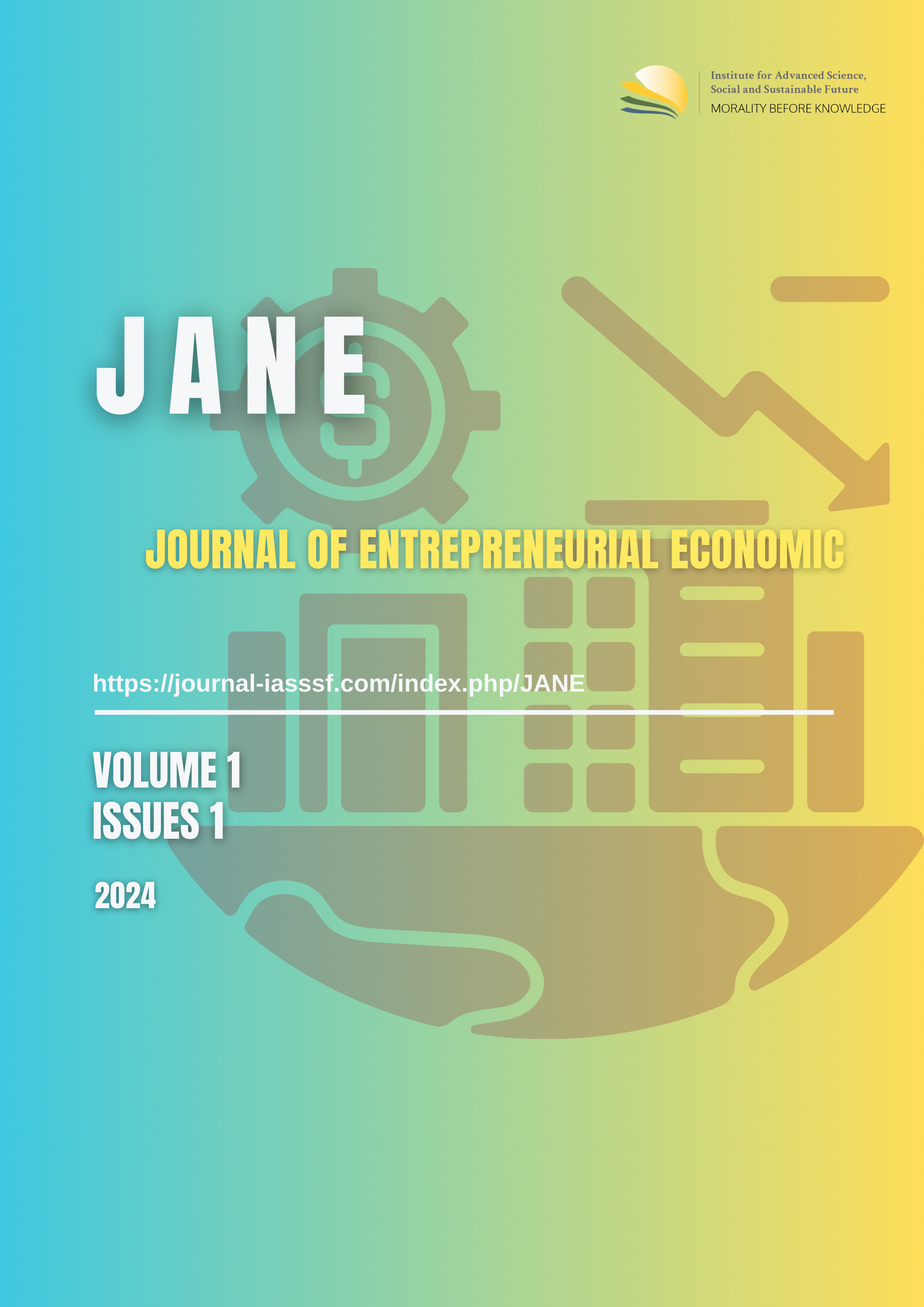Meningkatkan ketahanan UMKM terhadap bencana di Indonesia
DOI:
https://doi.org/10.61511/jane.v1i1.2024.617Keywords:
bencana alam, disaster risk, resiliensi, sosial-ekonomi, UMKMAbstract
Latar Belakang: Indonesia adalah negara dengan kerentanan yang tinggi terhadap bencana alam dan memiliki dampak yang signifikan terhadap sektor Usaha Mikro, Kecil, dan Menengah (UMKM). Tujuan dari penelitian ini adalah untuk merancang strategi dan intervensi yang efektif dan berbasis bukti untuk meningkatkan resiliensi UMKM terhadap bencana alam, dengan mempertimbangkan aspek sosial-ekonomi yang relevan. Metode: Penelitian ini mengembangkan sebuah program pengurangan risiko bencana (DRR) berbasis metode Systematic Literature Review (SLR). Melalui SLR, penelitian ini mengidentifikasi, mengkaji, dan mensintesis temuan dari literatur eksisting yang relevan dengan DRR dan UMKM. Temuan: Hasil sintesis kemudian diintegrasikan untuk mengembangkan program DRR yang komprehensif, inovatif, dan praktis untuk UMKM di Indonesia. Program yang dihasilkan diharapkan dapat menjadi referensi dan panduan bagi pemangku kepentingan dalam mengimplementasikan tindakan DRR yang efektif dan berkelanjutan dalam konteks UMKM. Kesimpulan: Hasil yang dapat disimpulkan bahwasannya proram ini merupakan langkah proaktif untuk menjaga keberlanjutan UMKM dan mendukung pencapaian Tujuan Pembangunan Berkelanjutan (SDGs) Indonesia. Program juga mencerminkan peran kunci Indonesia dalam upaya global dalam mengurangi risiko bencana dan membangun masyarakat yang lebih tahan bencana.
References
CRED. (2020). 2020 Natural Disasters: Fact Sheet with an Emphasis on Public Health Impact. Centre for Research on the Epidemiology of Disasters (CRED).
Djalante, R., Holley, C., & Thomalla, F. (2011). Adaptive governance and managing resilience to natural hazards. International Journal of Disaster Risk Science, 2(4), 1–14. https://doi.org/10.1007/s13753-011-0015-6
Gano-an, J. C., Cubin, L. D., & Campos, K. P. (2022). Unraveling Enterprise Continuity and Resiliency Factors: The Case of Micro, Small and Medium Enterprises. IJEBD (International Journal of Entrepreneurship and Business Development), 5(4), 632–647. https://doi.org/10.29138/ijebd.v5i4.1877
Hobbs, J. E., & Brosig, S. (2019). The Role of Trust and Risk Attitude in Farmers’ Diversification Decisions in Indonesia. Journal of Economic Behavior & Organization, 162, 201-216. https://doi.org/10.1016/j.jebo.2018.11.017
IFC. (2018). Banking on Resilience: The Small Business Resilience Program Guidebook. International Finance Corporation (IFC).
Neise, T., Sambodo, M. T., & Revilla Diez, J. (2021). Are Micro-, Small- and Medium-Sized Enterprises Willing to Contribute to Collective Flood Risk Reduction? Scenario-Based Field Experiments from Jakarta and Semarang, Indonesia. Organization and Environment, 34(2), 219–242. https://doi.org/10.1177/1086026619875435
Petit-Charles, N., & Chakroun, H. (2016). Understanding and Managing Business Continuity Risk: The Case of Micro, Small and Medium-sized Enterprises in the Caribbean. Disaster Prevention and Management: An International Journal, 25(4), 460-477. https://doi.org/10.1108/DPM-03-2016-0054
Pomeroy, R., Parks, J. E., & Watson, L. M. (2004). How is Your MPA Doing?. A Methodology for Evaluating Management Effectiveness. Ocean & Coastal Management, 47(3-4), 197-211. https://doi.org/10.1016/j.ocecoaman.2004.04.006
Rahmawan, A., Ma’rifat, T. N., & ... (2020). Risk Identification of Small Medium Enterprises in Indonesian Seafood Industries. Proceeding ICoFMR …, ICoFMR, 92–100. https://proceeding-icofmr.ub.ac.id/index.php/procicofmr/article/view/18
Rahmawan, D., Prasetyo, Y. W., & Kurniawan, J. B. (2019). Disaster Resilience and Small and Medium-sized Enterprises (SMEs) in Developing Countries: A Systematic Literature Review. International Journal of Disaster Risk Reduction, 36. https://doi.org/10.1016/j.ijdrr.2019.101102
Rennie, E., Golding, D., Peppin, S., Stevenson, S., & Stirling, T. (2013). Implementing the UNISDR Private Sector Alliance for Disaster Resilient Societies (ARISE) – Lessons from Two Pilot Projects in Indonesia and Myanmar. Procedia Economics and Finance, 6, 109-115. https://doi.org/10.1016/j.ocecoaman.2004.04.006
Seneviratne, K., Perera, S., Ginigaddara, B., Jin, X., Tang, L., & Osei Kyei, R. (2023). Good practices in COVID-19 risk reduction adopted by Australian construction enterprises. Built Environment Project and Asset Management, ahead-of-print(ahead-of-print). https://doi.org/10.1108/BEPAM-10-2022-0154
Sitinjak, I., Malau, A., & Silalahi, A. (2022). Organizational Ambidexterity and Public Policy Support as Determinants of Business Resilience Among SMEs in Medan, Indonesia: Findings From Regression and fsQCA. https://doi.org/10.1109/ICBIR54589.2022.9786517
Smith, R. D., Keogh-Brown, M. R., Barnett, T., & Tait, J. (2009). The Economy-wide Impact of Pandemic Influenza on the UK: A Computable General Equilibrium Modelling Experiment. British Medical Journal, 339. https://doi.org/10.1136/bmj.b4571
United Nations. (2019). Terminology on Disaster Risk Reduction. United Nations Office for Disaster Risk Reduction (UNISDR).
World Bank. (2014). Building Resilience: Integrating Climate and Disaster Risk into Development—The World Bank Group Experience. World Bank.
United Nations. (2015). Sendai Framework for Disaster Risk Reduction 2015-2030. United Nations.
Downloads
Published
How to Cite
Issue
Section
Citation Check
License
Copyright (c) 2024 Journal of Entrepreneurial Economic

This work is licensed under a Creative Commons Attribution 4.0 International License.














